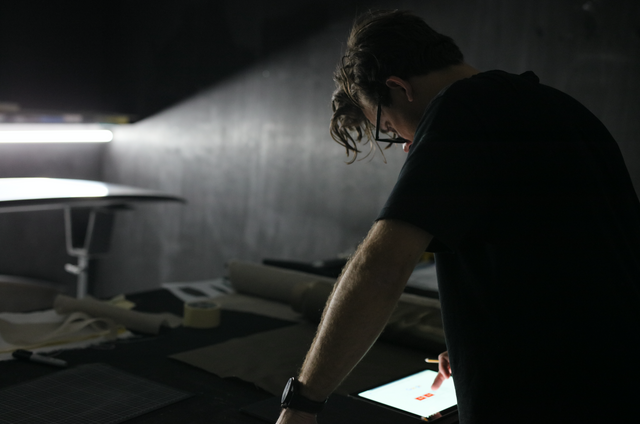CARBON LINES: A TIMELINE OF FUTUREFLEX, THE ORIGINAL CARBON FIBER SURFBOARD TECH.
11 years on, FutureFlex technology is not only synonymous with Haydenshapes and having largely influenced the brands signature black and white aesthetic, it’s arguably created an industry wide carbon fiber trend and opened doors for new innovation. As a Samsung ambassador and tapping into the ‘Do What You Can’t’ philosophy, we were asked to grab Hayden for a quick chat and take us back to the beginning when FutureFlex was just an idea with a whole decade of journey ahead.

Let’s start with a quick timeline.
2006: Hayden creates the very first FiberFlex prototype, ridden by Tom Carroll.
2007: The parabolic carbon fiber frame FiberFlex design files a Australian patent and officially launches to market as a technology offered to all leading surfboard brands in industry.
2008 – 2010: FiberFlex grows it’s licensed manufacturing to Gold Coast, Australia, Japan and USA, providing a global platform for shapers to have their boards built using the technology.
2011: Hayden brings FiberFlex tech back as exclusive Haydenshapes brand offering and changes the name to FutureFlex due to global trademark challenges. (Gordon & Smith had trademarked FiberFlex skateboards, thus, FiberFlex became FutureFlex).
2012: FutureFlex + Haydenshapes launch globally. At this point in time, there was a very minimal offering of custom surfboard technology within the surfboard space and FutureFlex and the popularity of the Hypto Krypto opens up new tech demand globally.
2014 + 2015: Hypto Krypto / FutureFlex is 3 x Surfboard of the Year across Australia and USA.
2015 – 2018: Carbon Fiber surfboard construction takes off and new innovation and release of new technologies takes place across industry. Where EPS carbon tech was once almost non existent, surfboard innovation hits a new peak in customer and retailer demand.
Rewinding back to 2007 when you designed and built the first FiberFlex prototype, take us through how it all came about.
The short version is that I had been running Haydenshapes in my own factory for around 4 years by that time and I decided that I wanted to build surfboards differently and create my own technology. I really liked the idea of parabolic flex patterns and experimenting with different materials that would really impact performance, speed, weight etc. I was actually having a conversation about the idea and floated by Nick Carroll during a car ride from Lennox Head to South Wall Ballina. That night I went home and literally dreamt about it, how to build it, what it would feel like to ride. As soon as I got home to my factory I began sourcing all the different materials and built the first one.
Why carbon rails?
From a flex stance, a stringer allows a board to tortionally twist, thus allowing the rail line flex and increase in rail line rocker. A parabolic flex pattern can tighten up the rail line flex and bring a faster flex response to the rail line rocker. Carbon fiber as a material can be used to create a very fast flex and control very accurately the amount of flex you want. Compared with a wooden stringer, which is made from a natural material, you can replicate the flex from board to board and the flexural memory will last a lot longer than wood.
Unlike today, there were no on the shelf materials or carbon tapes available. I had to go out and develop the materials used in FutureFlex from scratch. The carbon tape was created in Australia with Damien at Colan. The tape has evolved since the version I created day one, however I still work with the basically all of the same suppliers on the materials I use to build my boards whether they are manufactured in Australia or Thailand. The process and materials and the same regardless.
“A lot don’t realise that it was Hayden’s concept that helped us create our first custom Carbon UD tape and Double Bias cloth specifically for stringerless EPS reinforcement that are so widely used today. “
Damien Bensley, Colan Australia
Reflecting back on the last 12 years since you developed the FutureFlex tech, what would be your highlight?
That’s easy… The fact that it is still here. In the beginning it was a really tough sell because there was next to no tech offered in the market place during that time. It was basically PU or nothing. Haydenshapes dropped polyester resins completely from the offering and switched over to FutureFlex and PE (epoxy only) back in 2009 which was also unheard of at the time. From time to time brands would release new technologies, but they came and went quickly, so there was a lack of confidence in the industry whether the demand was really there, that it wasn’t just a gimmick that would come and go. So I think the bigger picture of FutureFlex and how it has had impact on innovation in general is definitely more of a highlight to me than the sales or awards. I really love to see the industry evolve and its a very different space now than it was when I started FutureFlex.
Here’s an interesting fact…. To this day, I have personally never snapped a FutureFlex. They are not unbreakable, but my favourite boards are still hanging around and feel like they did when I first rode them.
What’s the next progression of FutureFlex?
I’ve been working on it in the background for a few months now and prototyping. It will be eco-related. My goal is to design it in a way that the entire industry can benefit from. I’d definitely like to approach it from a ‘big picture’ standpoint.
A special thanks to Damian at Colan. In this video piece above, Hayden is using a Samsung Galaxy Note.
This content was created by Haydenshapes Surfboards for Haydenshapes.com.
